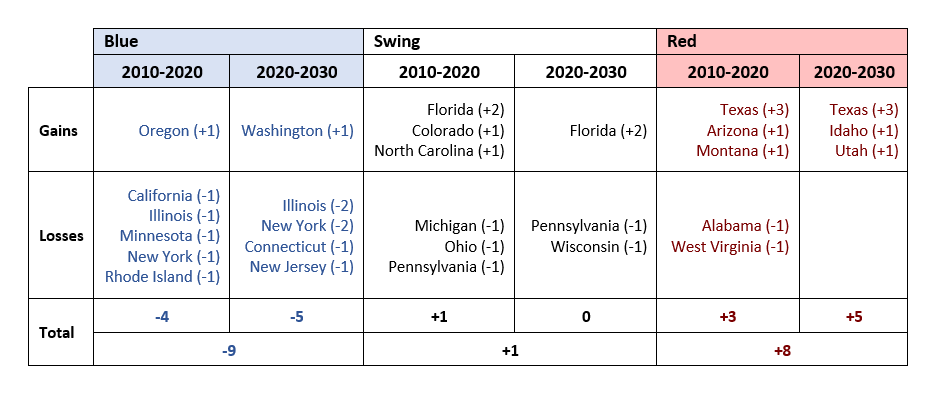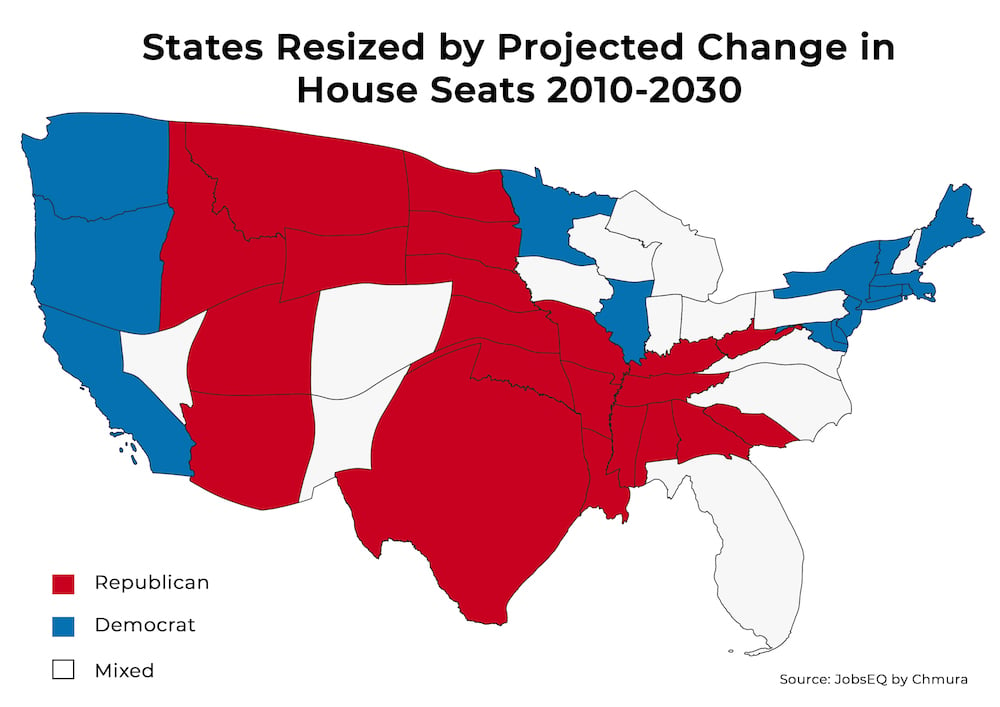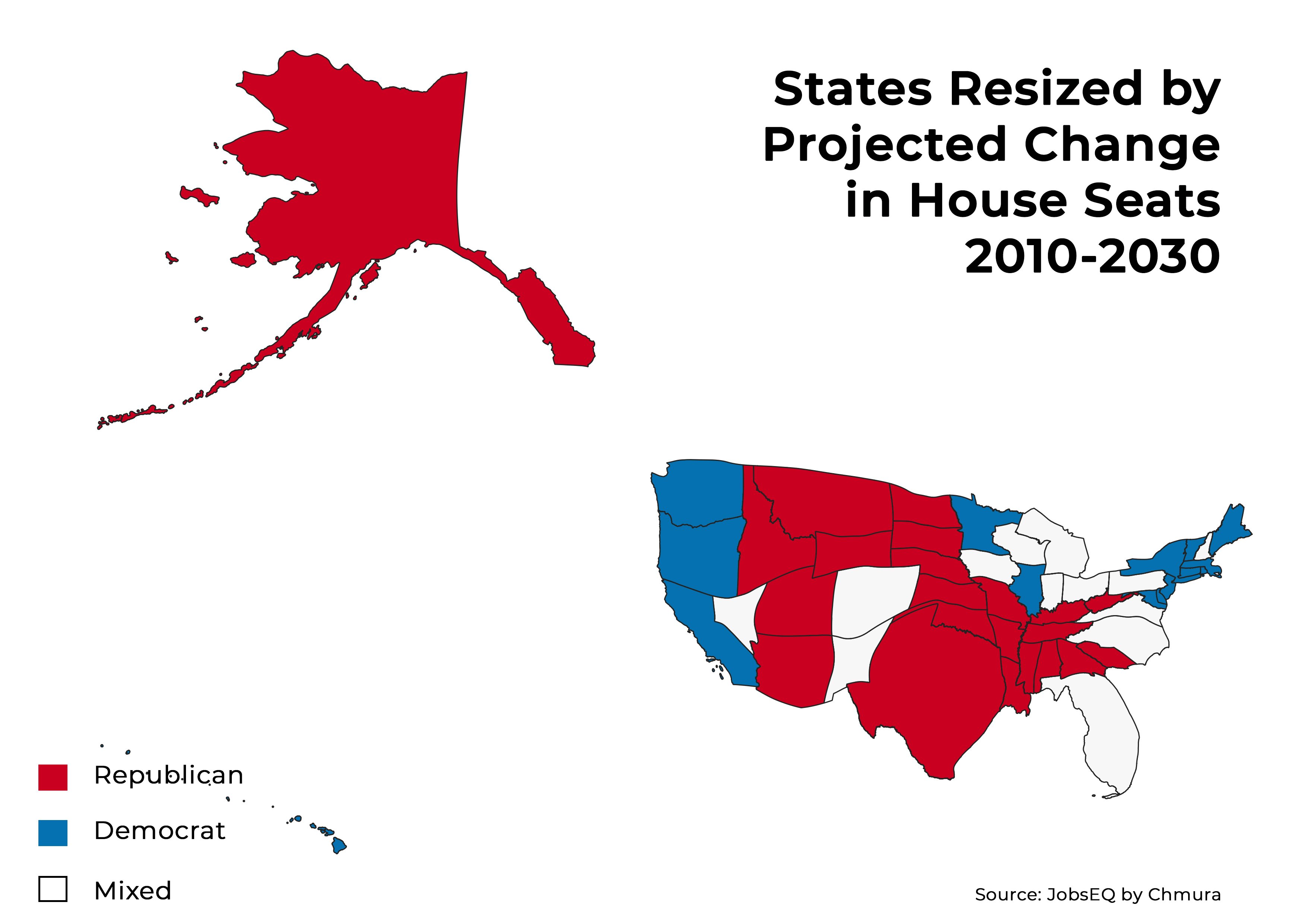By 2030, “red” states—those which have voted Republican in each of the last five presidential elections—are expected to gain a net eight additional U.S. House seats and electors in the electoral college, based on our latest population projections. “Blue” states—those which have voted Democrat in each of the last five presidential elections—may lose a net nine seats, and thus nine electors, over the same period, with the remaining one net seat expected to go to a state with mixed presidential election votes.
The number of seats in the U.S. House of Representatives has been fixed at 435 since 1913, but the distribution of those seats across the states can change after every decennial census (the next one is in 2020). Every state is guaranteed at least one seat, but the remaining 385 seats are divided according to the Method of Equal Proportions based on the population of each state.[1] This is also tied to the number of electors allotted to each state for presidential elections—one elector for each member in the House of Representatives and Senate.
Texas (+6) and Florida (+4) are projected to gain the most seats between now and 2030, while New York and Illinois are both expected to lose three. Among swing states, Pennsylvania could lose two seats, and Wisconsin, Michigan, and Ohio could each lose one. Following the 2020 Census, blue states are expected to see a net loss of 4 seats, while red states are expected to see a net gain of 3 seats.
Projected Gains and Losses in Congressional Seats Through 2030

Source: JobsEQ by Chmura
We can visualize the projected net gains/losses in Congressional seats by 2030 through this cartogram:

Changes in the number of seats and electors allotted to states that have reliably voted for one political party can impact which party controls the House and Presidency. Even with fairly strict criteria for assigning party colors, 37 states meet the threshold of having voted for the same party in each of the last five presidential elections. It is reasonable to assume that a gain or loss of an elector in one of these states will translate to a gain or loss of a vote in the electoral college for that party’s presidential candidate, but this is not guaranteed.
The changing demographics of the United States will have effects on our politics that no one can fully predict. However, if states continue to follow recent trends, the changes in population may also bring changes in the voting population demographics that could move current red or blue states into the swing state category. For example, population gains in cities and declines in rural areas of a state could benefit Democratic candidates in historically Republican states. Different rates of population growth by race and ethnicity could also shift voting patterns.[2] The Hispanic population (of any race) is projected to reach 21% of the U.S. population by 2030—up from 18% in 2017—and Hispanic voters have generally favored the Democratic Party in recent elections.[3],[4]
Actual population changes differing from the projections can also impact the apportionment. Based on our 2020 projections, Alabama would miss out on the 435th seat by just under 27,000 people.[5] Similarly, a difference of about 97,500 more people in Ohio or 156,700 people in Virginia would result in that state getting the last seat.
Based on current population projections, seats are expected to shift more to red states and away from blue states. If states continue to follow the same voting patterns, could the Republican party have a greater electoral advantage in both the U.S. House of Representatives and the Electoral College over the next decade?

Interested in politics? Check out our blog on Defense Budgets and Actual Spending: Presidents Don't Typically Get What They Ask For.
[1] JobsEQ population projections are used in this analysis. Several factors go into the population projections, including fertility rates and life expectancy, migration between states and counties, and international migration patterns. This forecast also aligns with the overall national-level Population Projections from the US Census Bureau.
[2] Demographics may suggest leanings toward a particular political party, but additional characteristics should be considered. For example, Hispanics may tend to vote for Democrats more often, but the Republican party in Florida generally performs better due to the large population of Cubans, see https://www.pewresearch.org/fact-tank/2016/11/15/unlike-other-latinos-about-half-of-cuban-voters-in-florida-backed-trump/
[3] Additional potential demographic changes in the population that could affect voting patterns include gender, education, and age. See https://www.pewresearch.org/fact-tank/2018/11/08/the-2018-midterm-vote-divisions-by-race-gender-education/.
[4] This type of analysis of voting patterns by demographics and red and blue states assumes that political parties maintain similar ideologies to those held today, but political parties have shifted frequently in history. For a light visual summary of ideological shifts and party realignment, see https://xkcd.com/1127/large/.
[5] The Michigan Population Studies Center has a helpful tool for these kinds of hypotheticals: https://www.psc.isr.umich.edu/dis/census/tools/apportionment/